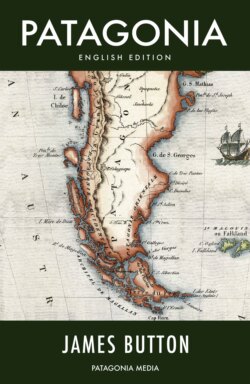Читать книгу Patagonia - James Button - Страница 5
На сайте Литреса книга снята с продажи.
Contents
ОглавлениеPrologue
Introduction
Geographical Delineation
Chapter I
Introduction to the extent of Patagonia
Defining the borders of the Patagonian region
Archaeological delimits of Patagonia
Ethnic delimits of Patagonia
General borders of Patagonia
Chapter II
Life in Patagonia
Patagonian flora and fauna
Flora
Fauna
Chapter III
Origins of human occupation in Patagonia
Earliest human traces
Monte Verde
Analysis of the discovery of the oldest archaeological remains in Patagonia
Conclusion regarding Monte Verde and Patagonia
Chapter IV
Indigenous population of Patagonia
Food sources of the Patagons
The different Patagonian tribes
Patagonian tribes on the Atlantic side of the Andes
Patagonian tribes on the Pacific side of the Andes
General classification of the Patagonian tribes
Tribal beliefs and myths
Patagonian tribes
• The Aonikenk or Southern Tehuelche
• The Günun-a-küna or Northern Tehuelche
• Onas or Selk’nam of the Tehuelche People
• The Huilliches
• The Cuneos
• The Chonos
• The Alacaluf or Kaweskars
• The Yaghans or Yámanas
• The Pehuenches
• The Puelches
• The Poyas
• The Tehuelches
Food sources, clothing, hunting tools, and weapons
• Fishing
• Hunting for meat
• Vegetables
• Drinks
• Clothing
• Weapons
• Boleadoras
• Mythology regarding boleadoras
• Boleadoras Perdidas
• Boleadoras with two or three weights
Chapter V
Patagon Survival and Organization
Survival
Organization and settlements
Chapter VI
Discovery of the Americas
Maritime Explorations
First voyage: discovery of the sea route to India
Discovery of Patagonia
Chapter VII
Analysis of the discovery of Patagonia: 14th - 15th Century
Christopher Columbus
Religious reforms in Europe
Amerigo Vespucci
Toscanelli: a connection with the future
Mundus Novus
A name for the New Continent: America
Ferdinand Magellan
Chapter VIII
The Magellan Expedition and the return to Spain
Léon Pancaldo
Antonio Pigafetta
Chapter IX
The House of Trade
Explorers
Discovery of Patagonian Lands
The Explorers and the Patagons
Terra Australis Incognita
Corsairs in the southern ocean
Circumnavigation of the world
Drake – from England to the Pacific Ocean
War between England and Spain
The English privateer Sir Thomas Cavendish in Patagonia
Chapter X
Mapping the world
Western Patagonia
Chapter XI
America and Patagonia
The Conquest of America
Political entities in the American Colonies
The work of the religious missions
Chapter XII
Developments in the wake of the exploration and conquest of America and Patagonia
Navigare necesse est (to sail is necessary)
Heading south
New trading routes
Chapter XIII
Origin of the name Patagonia
Patagon vocabulary
A brief comparative overview of the three Fuegan languages
Chapter XIV
El Dorado: magnet for explorers in the 16th Century
The Spanish Crown in Patagonia
Atmosphere in Magellan’s Patagonia
The City of the Caesars
Foundation of Fort Sancti Spiritus
Incursions by explorers in Patagonia
The first explorations via land routes
First attempts at sovereignty in the Straits of Magellan
Juan Ladrillero
Pedro Sarmiento de Gamboa
The Alcazaba Expedition to Patagonia
Juan Fernández
Dutch expeditions to Patagonia
The Dutch mariner Isaac Le Maire
The Nodales brothers continue Le Maire’s work
English expeditions to Patagonia
The navigator John Narborough
James Cook
Scientific expeditions to Patagonia
Mapping
Chapter XV
Southern Patagonia becomes the established route between the Atlantic and Pacific Oceans
Chapter XVI
Missionary work in Patagonia during the 17th - 18th Century
The Jesuits
The Jesuit Alonso de Ovalle
Father Luis de Valdivia
Nicolás Mascardi
Foundations for evangelization in South America
The King of Araucania and Patagonia
Thomas Falkner
The Salesian missionary plan
The Kingdom of Araucania and Patagonia
A romantic explorer of Patagonia
Discovery of the Beagle Channel
Further attempts at colonization
Trafalgar and controlling the seas
Alliances after independence
Trafalgar and Waterloo – the fall of Napoleón
Colonization projects in Patagonia
The Popham-Miranda Project
The Peninsular War (1808-1814)
The path to independence in South America
Liberation army of Perú
The Republic of Chile
The republics of the southern cone
The collapse of Spanish rule
Lord Cochrane
Operations by the Chilean Navy under Lord Cochrane
First blockade of Callao
The Capture of Valdivia
Assaults following the Capture of Valdivia
Independence of Perú
Sovereignty in southern Chile
Chapter XVII
Other explorers of mainland Patagonia in the 19th Century
Guillermo Cox
Emil Hans Steffen
The University of Princeton in Patagonia
Francisco Pascasio Moreno
Chapter XVIII
European developments and the impulse for emigration to Patagonia
Welsh immigrants in Patagonia
The North American presence in Argentine Patagonia
The colonization of Chilean Patagonia
The pioneer of German colonization Bernardo Eunom Philippi
German settlement in Patagonia
Travel via the southern oceans
The German legacy in Chile
Chapter XIX
Commercial exploitation of Patagonia
Business in southern Patagonia
The coal industry
The commercial vision of José Menéndez
Merchant marine commerce in Patagonia
Antoine de Saint-Exupéry in Patagonia
Croatian immigration to Patagonia
Bibliography
James Button
